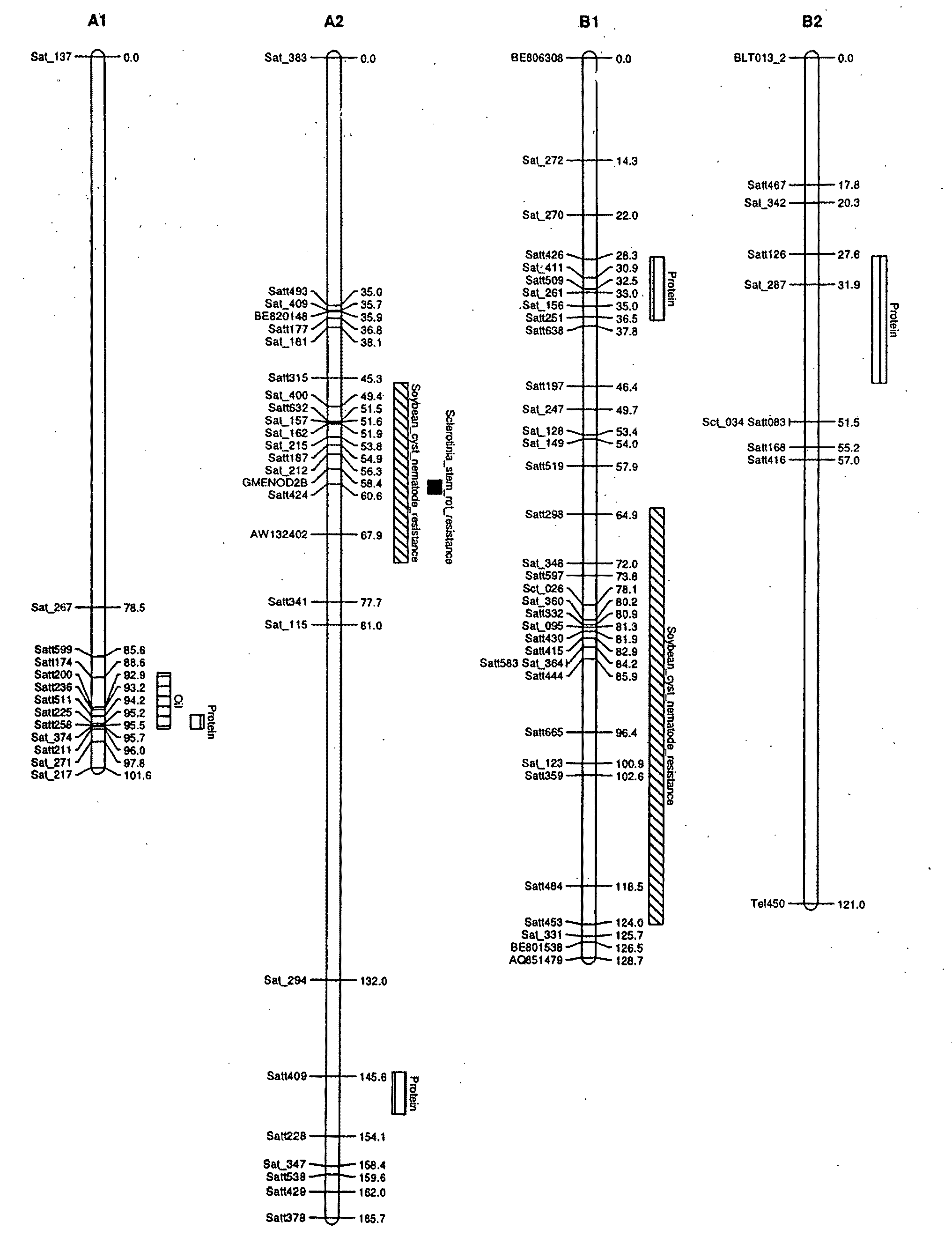Markers For Aphid Resistant Germplasm In Soybean Plants
a germplasm and soybean technology, applied in the field of soybean plant aphid resistance germplasm identification, can solve the problems of overall yield and quality reduction, yield loss, leaf wilting, curling, yellowing, etc., and achieve the effects of enhancing aphid resistance, enhancing aphid resistance, and enhancing aphid resistance in a soybean plan
- Summary
- Abstract
- Description
- Claims
- Application Information
AI Technical Summary
Benefits of technology
Problems solved by technology
Method used
Image
Examples
example 1
Materials and Methods
[0410]Soybean plant introductions (PI) from MG 0 to III were obtained from the USDA Soybean Germplasm Collection in Urbana, Ill. (Table 1). A total of 2,147 PIs were evaluated in 2002 and 2003, including 5 MG 0 accessions (PI 468920 to PI 597467), 530 MG I accessions (FC 03609 to PI 612761E), 979 MG II accessions (PI 253650A to PI 612758E), and 633 MG III accessions (FC 02108 to PI 612759D). Accessions originally from northern China were selected, as the climatic conditions are similar to those in the northern USA, where the soybean aphid over-winters, and because soybeans in that region have been exposed to aphids over the years. ‘Williams 82’ was included as a susceptible check in these experiments and one or more of the three resistant genotypes, ‘Dowling’, ‘Jackson’, and PI 71506 (Hill et al., (2004) Crop Sci. 44: 98-106), were included as resistant checks. Both the susceptible and resistant checks were obtained from Dr. Glen Hartman, USDA-ARS at Urbana, Ill...
example 2
Illustration of the Visual Rating Scale Used to Establish the Damage Index (DI)
[0431]The following index was used for establishing a Damage Index rating. 0=No aphids, plant appears normal and healthy; 1=Less than 100 aphids per plant, plant appears normal and healthy; 2=101-300 aphids per plant, mostly on the young leaves and the tender stem at top of plant, plant appears normal and healthy; 3=301-800 aphids per plant, leaves slightly curly and shiny, young leaves and stems covered with aphids; 4=More than 800 aphids per plant, plants stunted, leaves severely curled, yellow, covered with sooty mold and cast skins. (FIG. 1).
example 3
Choice Tests in 2002
[0432]In the first year of evaluation in the field cage, the average number of aphids per leaflet ranged from 0 to 500. In the greenhouse, the average number of aphids per leaflet ranged from 0 to 170. Results from the visual rating and calculation of the DI showed that 1008 and 973 of the accessions evaluated in the field and greenhouse, respectively, were susceptible to the soybean aphid (DI>30%). Twenty-eight and 62 accessions did not germinate in the field and the greenhouse, respectively. The correlation between the average number of aphids per leaflet 10 days after inoculation and the DI of an accession was low (r=0.16, n=1043, p<0.0001). Seven of the 1043 accessions appeared to be resistant (DI<30%) to the aphid in the field cage, while eight accessions showed resistance in the greenhouse (Table 2).
[0433]Three of these accessions were resistant in both the field and greenhouse evaluations. The accessions that showed resistance in one test, field or greenho...
PUM
| Property | Measurement | Unit |
|---|---|---|
| size | aaaaa | aaaaa |
| temperatures | aaaaa | aaaaa |
| temperatures | aaaaa | aaaaa |
Abstract
Description
Claims
Application Information
 Login to View More
Login to View More - R&D
- Intellectual Property
- Life Sciences
- Materials
- Tech Scout
- Unparalleled Data Quality
- Higher Quality Content
- 60% Fewer Hallucinations
Browse by: Latest US Patents, China's latest patents, Technical Efficacy Thesaurus, Application Domain, Technology Topic, Popular Technical Reports.
© 2025 PatSnap. All rights reserved.Legal|Privacy policy|Modern Slavery Act Transparency Statement|Sitemap|About US| Contact US: help@patsnap.com



